Race information
- What? Moab 240
- When? October 8-12, 2021
- How far? 240.3 miles (386 km)
- Where? Utah, USA
- Website: Moab 200
- Strava activity: Strava
- Finish time: 92 hours 50 mins
Goals
| Goal | Description | Completed? |
| A | Sub-96 hours | Yes |
| B | Finish | Yes |
Training
For the last year or so I had been hearing a lot more about 200+ mile races, and after watching many great videos on YouTube/Vimeo, I came to the conclusion that this was a different ultra running experience compared to 100 miles. I was intrigued, but not yet willing to pull the trigger on a race. Whilst back in the UK for Christmas I mentioned the idea to Sam. After a bit of discussion, he said if I signed up, he would crew. This was the extra bit of motivation that I needed, and over a New Year’s catch-up beer with friends, I decided to pull the trigger!
A few months prior, I had completed Yeti 100 (September 2020), and subsequently attempted an FKT in San Diego. Unfortunately this resulted in a tweaked knee, which meant a couple of months of light running. Thankfully, the knee pain subsided after this period. Post the resolution of the knee pain, I began a structured plan incorporating 3 days a week of strength training and a gradual ramp-up to about 60 miles (100km)/week of running.
Whilst Moab was my A-race of 2021, I also had a mile and marathon running goal. To achieve these goals I first focused on building a base and then hit a mixture of speed sessions and long runs. Things were going very well and I was starting to feel the strongest I had ever felt, which was great.
Just as the plan was coming together, bad luck struck. Whilst doing a 10km run with 1km fast-floats (5min/mile pace), an obstacle unexpectedly veered into my path. I had to abruptly correct course but as I stepped off the curb onto the road, I tweaked my left calf muscle. At first, I thought it was just a leg spasm, but that didn’t feel quite right. After standing around waiting for the pain to subside, I decided to abandon the run. I jumped on a scooter, went home, and arranged to see a physical therapist. Unfortunately, the injury was a strain of the soleus muscle, I would say between a grade 1 and 2. This happened on June 14, which gave me around 4 months to recover and get back to fitness. Plenty of time right?
After taking a couple of weeks off, my calf felt a lot better, and I started doing a few light training sessions. After a week or so I decided to push a bit harder, unfortunately this was a mistake as I re-injured the calf. What an annoying injury this turned out to be! I took a few more weeks off, doubled down on the strength work, and began training again. Finally, 2 months after the original injury, I was able to up the weekly mileage and before Moab, managed a max week of 40 miles (64km). Not exactly ideal for a 200+ mile race, but with the base, hopefully this would be sufficient to get me to the end…
Pre-Race
Throughout this period, I had been watching and reading race reports on Moab and similar races such as MDS. I imagined that there may be some techniques that would prove useful in this race that I hadn’t used before. Two in particular jumped out:
- Running Poles
- Taping Feet
Rather than poles, I had historically used the hands-on-knees technique. After a weekend of research, I ordered a pair of Leki poles and began learning to use them. At first, I felt quite clumsy and they seemed to increase effort, but as my technique improved the poles started to help and I enjoyed a lower heart rate on hills with the same pace!
I’d also read a lot about taping feet, this reminded me that Sam had his feet taped for Western states. I wasn’t certain how useful it would be, but decided to train with taped feet to get used to the feeling. Sam had gifted me the bible of foot taping, Fixing Your Feet, and I read it cover-to-cover.
Whilst learning how to pole, I began capturing a long list of every item I thought I may need on the run. When packing and executing a 100 mile race, I would usually forget 1 or 2 items. Typically, the consequences of forgetting these items was low. However, reading the race reports, one important aspect of running 200+ miles seemed to be risk-mitigation, so I kept a very organized list of items I wanted, how many I wanted, how many I owned and what I had packed! If you are curious about the list, here is a link to a copy of that document!
2 Days before the race
Flying up to Utah on Wednesday morning, 2 days in advance of the run, allowed me to pick up last-minute items in Salt Lake City before driving down to Moab. The original plan was for Sam and a chap called Edward to join me for race-day and crew duty, but due to COVID travel rules, this proved infeasible. Somewhat ironically, I would be running the race, but self-supported.
The Facebook race group was very active with discussion about potential bad weather over the weekend, so even though I had a rain jacket, I decided to upgrade in a local REI before heading south - I wouldn’t want to DNF just because of wrong clothes! After a very pretty drive down south, I arrived in Moab around 6 pm. One thing I hadn’t figured out was my exact drop-bag strategy so I decided to take a first pass at it. Tiredness and the complexity of moving drop bags meant this was an abject faliure, and I instead opted to sleep early and try again in the morning with Sam, my now remote crew team!
8 hours later I awoke feeling refreshed, phoned Sam and began sorting out drop bags. I had 3 key drop bags; each would move between 2 aid stations, covering a total of 6 aid-stations. Each drop bag would have a sleeping bag and other critical items such as spare battery packs. Sam and I diligently worked through the logistics to finalize their contents, an endeavour which took a surprisingly long time. The complexity lay in figuring out the right sequence of bags to ensure I had the right gear at the right time. Probably the 2 most critical drop bags were the ones at Shay Mountain (ETA night 2) and Rd46 (ETA night 3). These were the locations where I expected it to be very cold, and most probably where I would sleep. In particular, for Rd46 which was just before going over the highest and coldest part of the course, I wanted to ensure I had a surfeit of layers to survive a potential night siege over the mountain!
After sorting out all my stuff, I popped over to the race check-in and then met my friend Kit for dinner. Kit would also be running the race, with support from his wife and his buddy, Greg. We met at a diner, I passed on food as I had already eaten a very large pizza for lunch, opting for a chocolate milkshake instead! Nervous chatter and then back to the hotel for a lovely night of sleep!
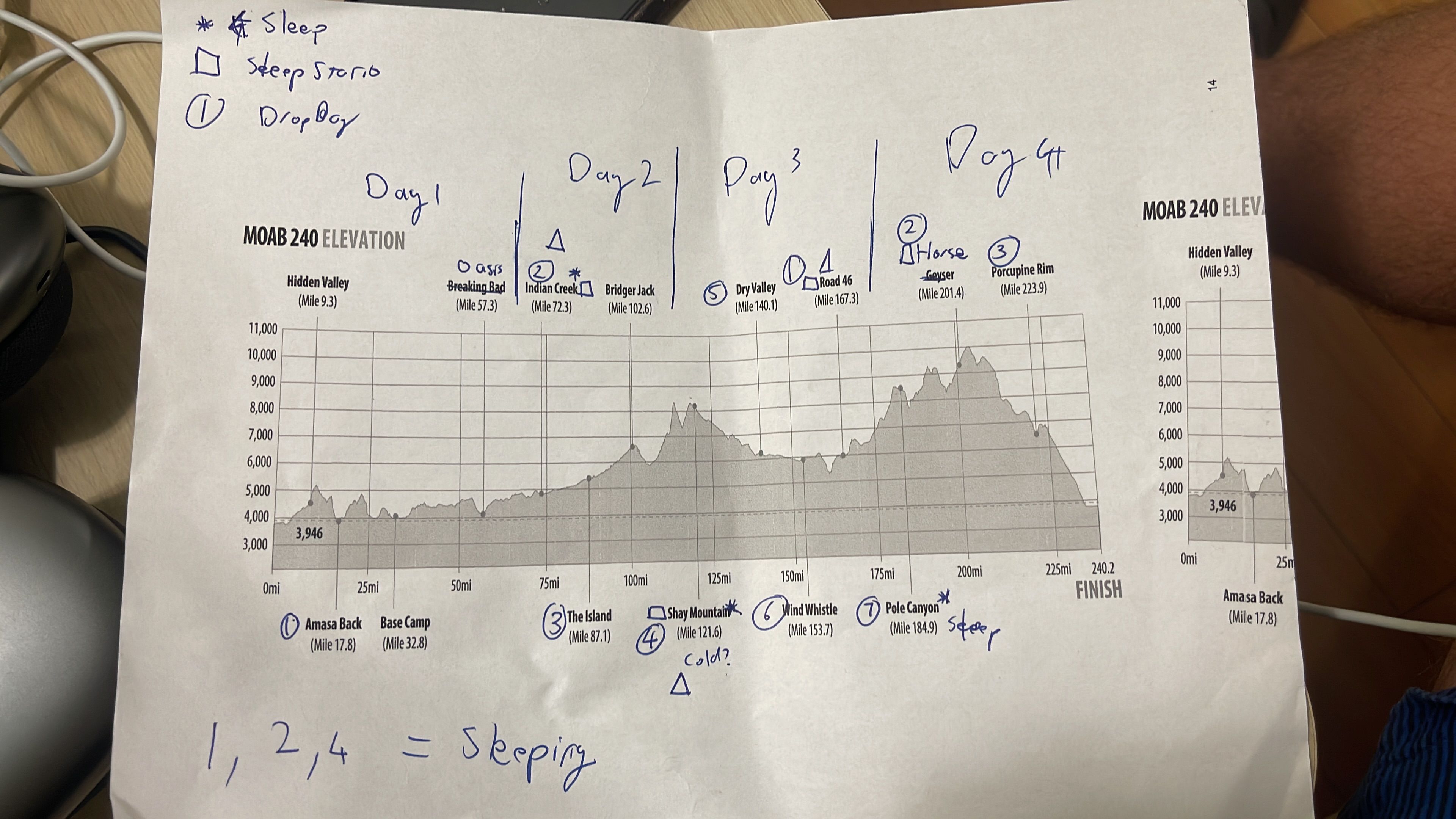
A pacing map
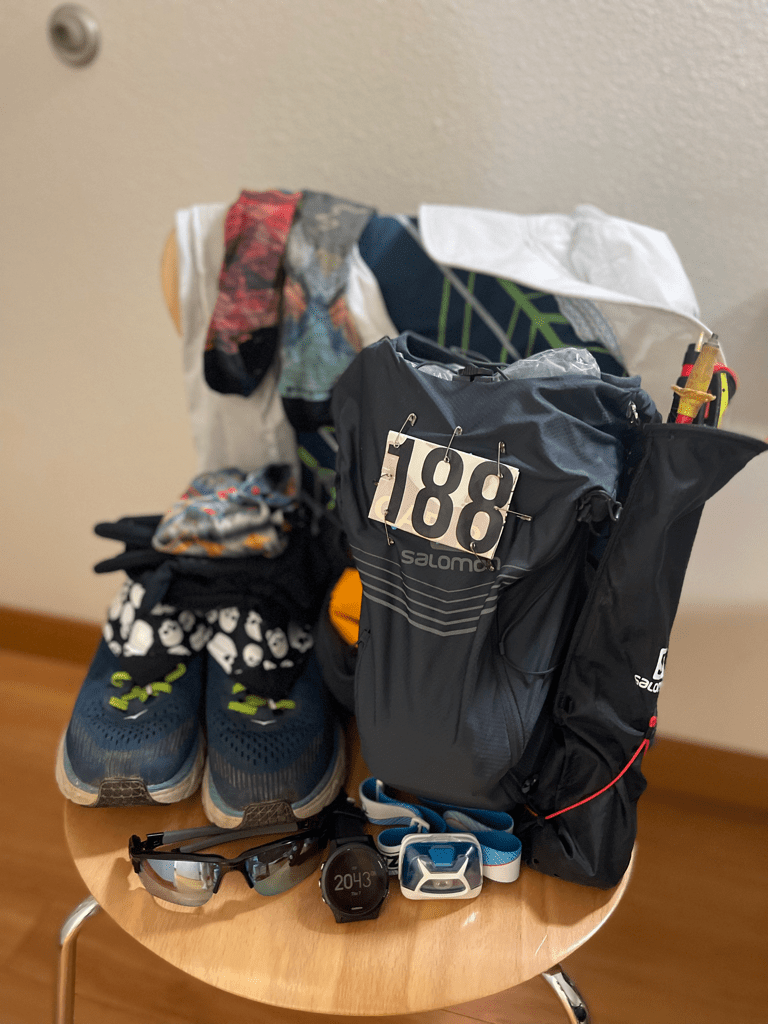
Very full running vest
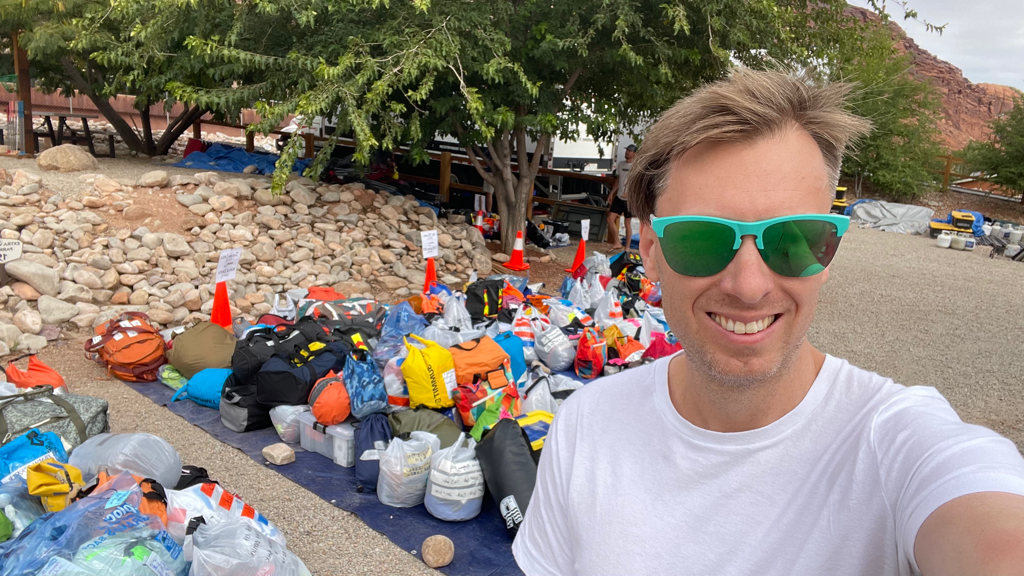
Extensive drop bag system

Race check-in
Race
Day 1 - Friday - (0 to 71 miles)
Aid stations: Hidden Valley, Amasa Back, Base Camp, (water), The Oasis, (water), Indian Creek
At 4:30 am I woke up after a really horrendous night sleep. All-in, I had around 90 mins of sleep - really not a great start. In comparison, before most 100’s, I get a pretty decent sleep, 6 to 7 hours. Sadly, the nerves got the better of me on this one… After liberally applying Squirrel’s Nut Butter to my skin and chamois cream to every seam of my clothes, I was ready to rock-n-roll. Kit, Alla and Greg picked me up at the hotel and we were off to the start. We got there in time to get our live trackers, waited for the famous destination trail mantra, and off we went!
As expected with the dark start, I lost sight of Kit within the first few minutes. At this point, I just kept to myself and focused on getting to the first aid station. The morning was cool and refreshing, with the city of Moab encased by beautiful Mesas. As the sun began to rise we ran along a lovely ridge-line and dropped into the first aid station, Hidden Valley. Water. Food. Onwards.
The ascent out of Hidden Valley took us up a steep hill to the top of the Mesa we had been running along. There were a few minor drops of rain, but overall the weather was perfect. At this point, I started chatting to a fellow first-time 200-miler runner, Jon. Soon after this, we ran into 2 more keen runners, Scott and Lucja. After spending most of the race until now by myself, it was great fun to have a few people to chat with. The world of ultra-running is pretty small, and I was recanted with interesting stories of Scott’s recent run at Badwater and Lucja’s adventure at Bigfoot 200. As we arrived at the Amasa Back Aid Station, I got to meet Lucja’s partner, Dion, and his dog Gobi, from the book Finding Gobi! Talk about running with the stars :). Just as we hit the Aid Station, it began raining very hard causing a little chaos and when I exited the Aid Station I was on my own again.
After a brief interlude via a precarious river edge, I began ascending another steep Mesa. During the ascent I had a bit of a low moment due to my brain stupidly calculating: 29 km done with 351 km to go - blimey, how is this possible?
As I crested the top of the Mesa, I was rewarded with a stunning view of the Horse-Shoe River Bend. Underfoot, the rock had become slick from the intermittent rain, and I was reminded of the risks when I came upon a runner with a hurt ankle. Someone was attending to him so I carried on, I hope he managed to get over his injury and continue! As often happens with these long races, I ended up back with my earlier running friends and we continued our run together down the amazing Jacob’s Ladder and arrived at the next aid station, Base Camp, at 1 pm - 7 hours and 33miles/52km done!
On the minds of all the runners was the next section: it happened to be around a marathon’s distance without aid, with a bonus chunk of elevation gain thrown in for good measure. I made sure to head out with Lucja and Scott for a little company on this long stretch. Just before setting off, I quickly wolfed down a couple of burgers, coke, and a packet of crisps!
So far I felt pretty good - the sun had not come out in too much force, nutrition was going down well, and I was having a great time hearing all the amazing adventures that Scott and Lucja had been up to over the last few years. In particular, Badwater and Oman by UTMB sounded like particularly challenging races! Halfway through this section we hit the water-only aid and I topped up, before heading up into one of the most gorgeous Mesas with truly spectacular views of Moab - postcard stuff!
Around 5 pm or so, we all started to have our battles to fight. The poor night’s sleep was starting to catch up with me, and I was feeling very out of sorts. Scott had some minor nutrition issues, and Lucja - well she seemed fine! As such, our group slowly splintered apart as we each worked our way through physical and mental funk. I tried to keep Lucja visible, but this proved futile. I eventually caught up with Jon from earlier and we chatted for a bit. Everyone was feeling the grind of this long section and seeking the respite of The Oasis. As the sun sunk, I pushed myself along counting down every km, and Scott overtook me feeling much better!
Seven and a half hours after setting off from the previous aid station, I arrived at The Oasis, 57.3 miles or 91 km done. I was feeling a bit miserable, so grabbed some soup, quesadilla and took a 5 minute nap on a camping bed. Lucja and Jon were sitting and chatting around the fire, but I wasn’t in the mood to talk to anyone. Seeing a big group of people arriving, I decided it was time to push on. The Oasis wasn’t a huge Aid Station, and next one would have more goodies and be better for a longer break. Leaving the Aid Station, there was a thought of asking the volunteers how Kit was doing. Was he ahead or behind me? Probably not the right mental state to want to know, ironically, the answer would be revealed in the not too distant future.
The next section was a very runnable trail with nice smooth track and slightly rolling hills. I tried to bounce back from my previous slow end of the last section with a decent pace. Quickly it began getting dark and I was all alone, creepy. At this point it felt like something was stalking me in the bush, perhaps a wild animal? Every time there was a rustle, I would shine the light in the direction of the noise, the noise would stop, there was nothing there. This pattern repeated itself for the next 30 mins or so. Eventually, my only option was to make peace with whatever beast was following me. Later it would turn out the noise was made by the ultra vest rubbing against my shirt, gah.
Feeling pretty horrendous, the steps became hard, a terrible headache, slight dizziness, and no energy. Once again, a foolish calculation confirmed that upon hitting the Indian Creek Aid Station, only 71.3 miles or 114 km would have been run, with 168 miles or 266 km still to go. I suddenly felt like I couldn’t do this. Feeling bad was no stranger during 100’s, but usually there would only be about 26 miles or 40 km to go. How could one do the rest of the distance? I couldn’t, it wasn’t my day. The next aid station would be the end. “Don’t be an idiot - just push on”, but all I could think about was going back to the hotel, having a long sleep, and shower. What was the issue? Sadly, nothing in particular felt wrong, it was just a cumulative demise.
As these bad thoughts floated around, the side of the trail begun to look enticing for a quick rest. Sitting down and turning off my head-torch to complete darkness made my hearing more acute. The thumping of another runner coming up the trail was now clear. In most situations it was a standard gesture to nod or say hello to a fellow runner but this was not most situations. As the sprightly runner overtook me, I caught sight of their very distinctive black and orange bag - it was Kit! I was simultaneously glad that he was moving well but frustrated at my own slow struggle, sadly I couldn’t bring myself to say hello…
Shortly afterwards, I forced myself to push through the last few miles to the Oasis Aid Station. On entering the aid station, I followed the sage advice of any person who had DNF’d - don’t quit as you enter the Aid Station. Walking over to the food tent, I grabbed a hamburger and a coke and slowly ate in-front of the camp fire. 10 mins passed by and continuing was inconceivable. One of the volunteers at the Aid Station was floating around helping people and I told her I couldn’t go on. She was very friendly and we discussed the root cause of my wanting to quit. After listening to a rambling list of reasons, she mentioned that if I were to quit now, the first ride out would probably be in the morning, a 6-hour wait. She suggested sleeping on the decision. I couldn’t argue with this logic, so I grabbed my sleeping bag, hit the sleeping tent, and closed my eyes - no alarm clock set!
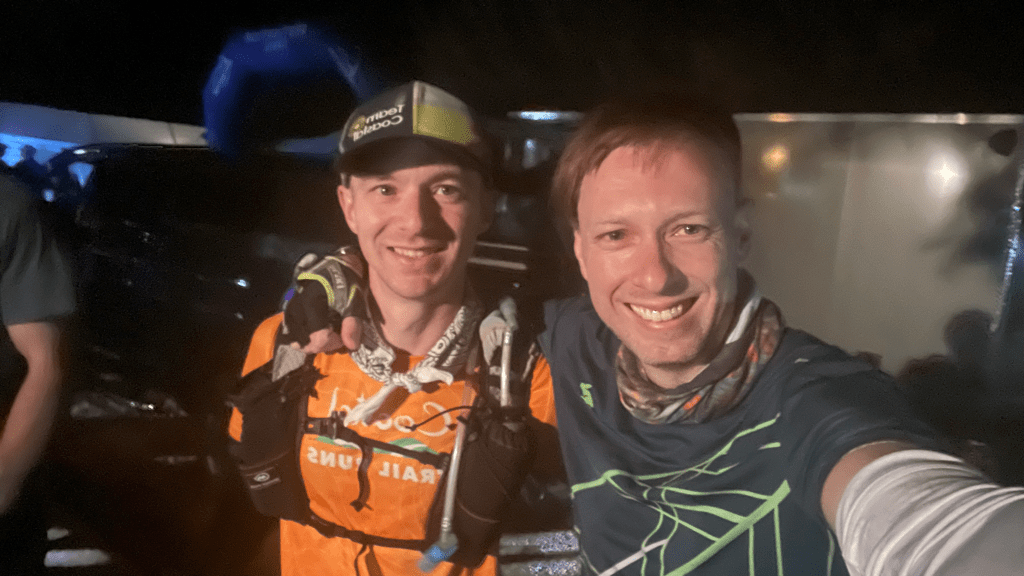
Kit and I before the start!
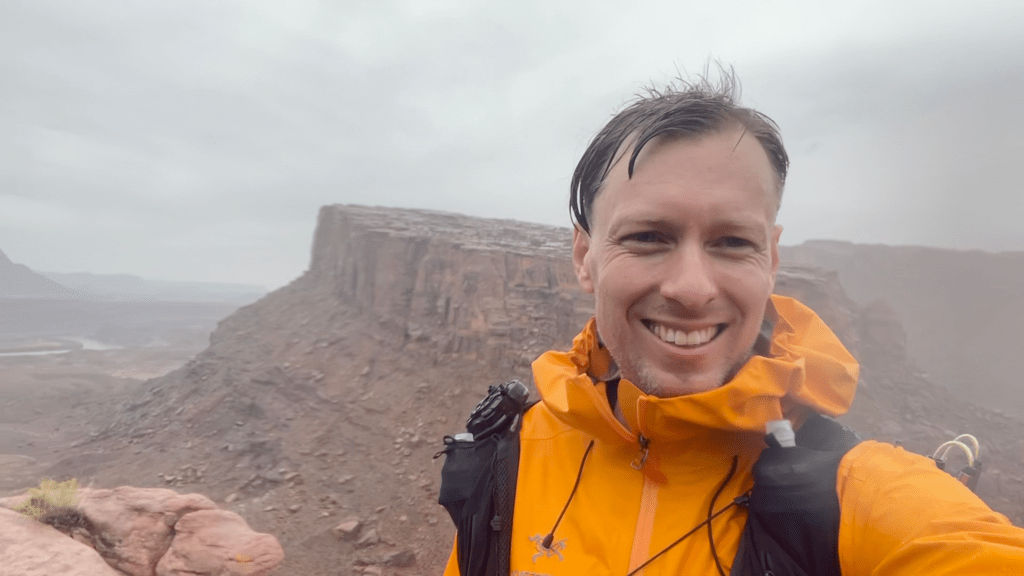
Lovely views but a bit wet
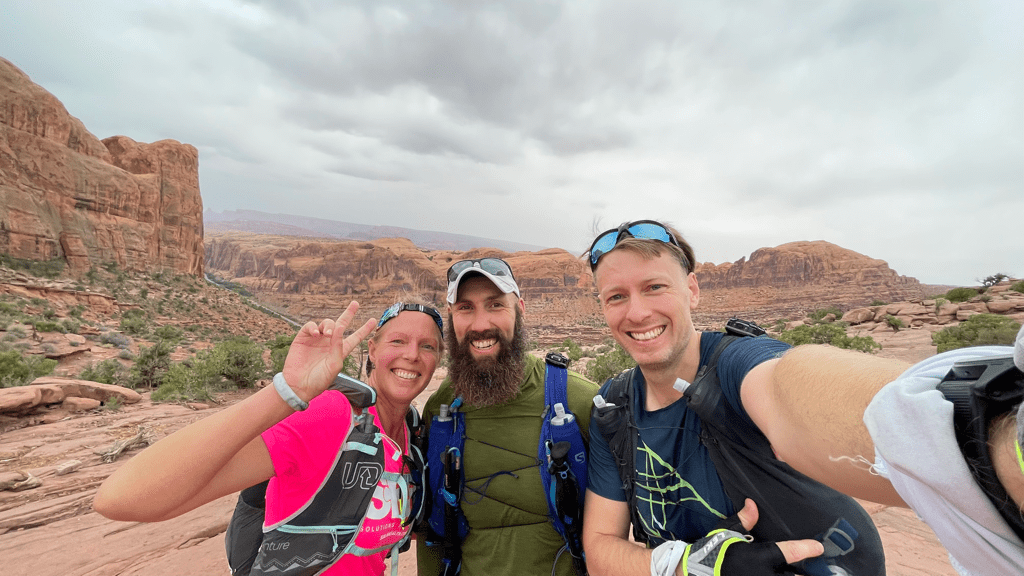
Lucja, Jon and I
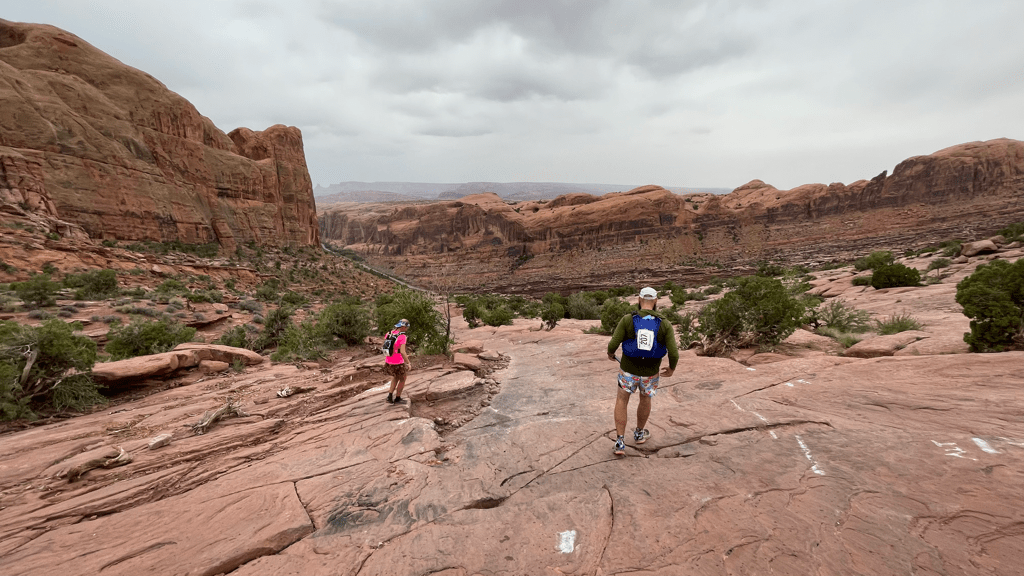
Down the wet slick rock
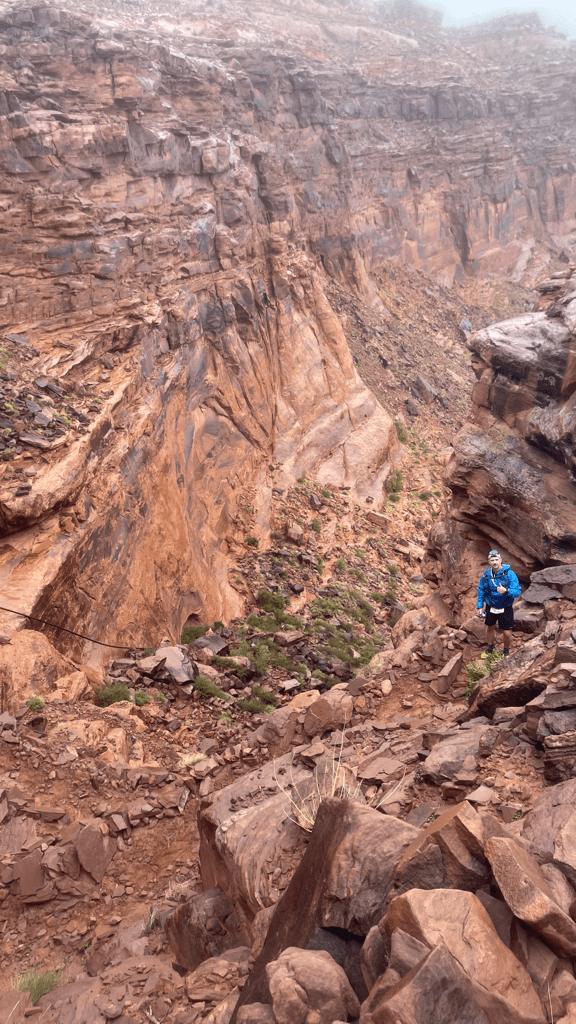
Looking down at Scott on Jacobs Ladder
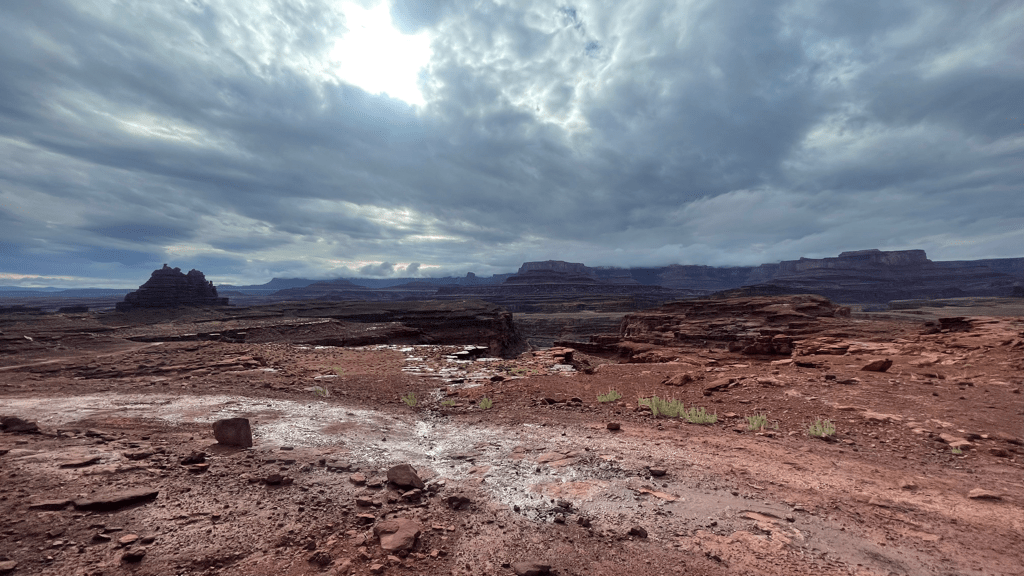
Amazing scenery
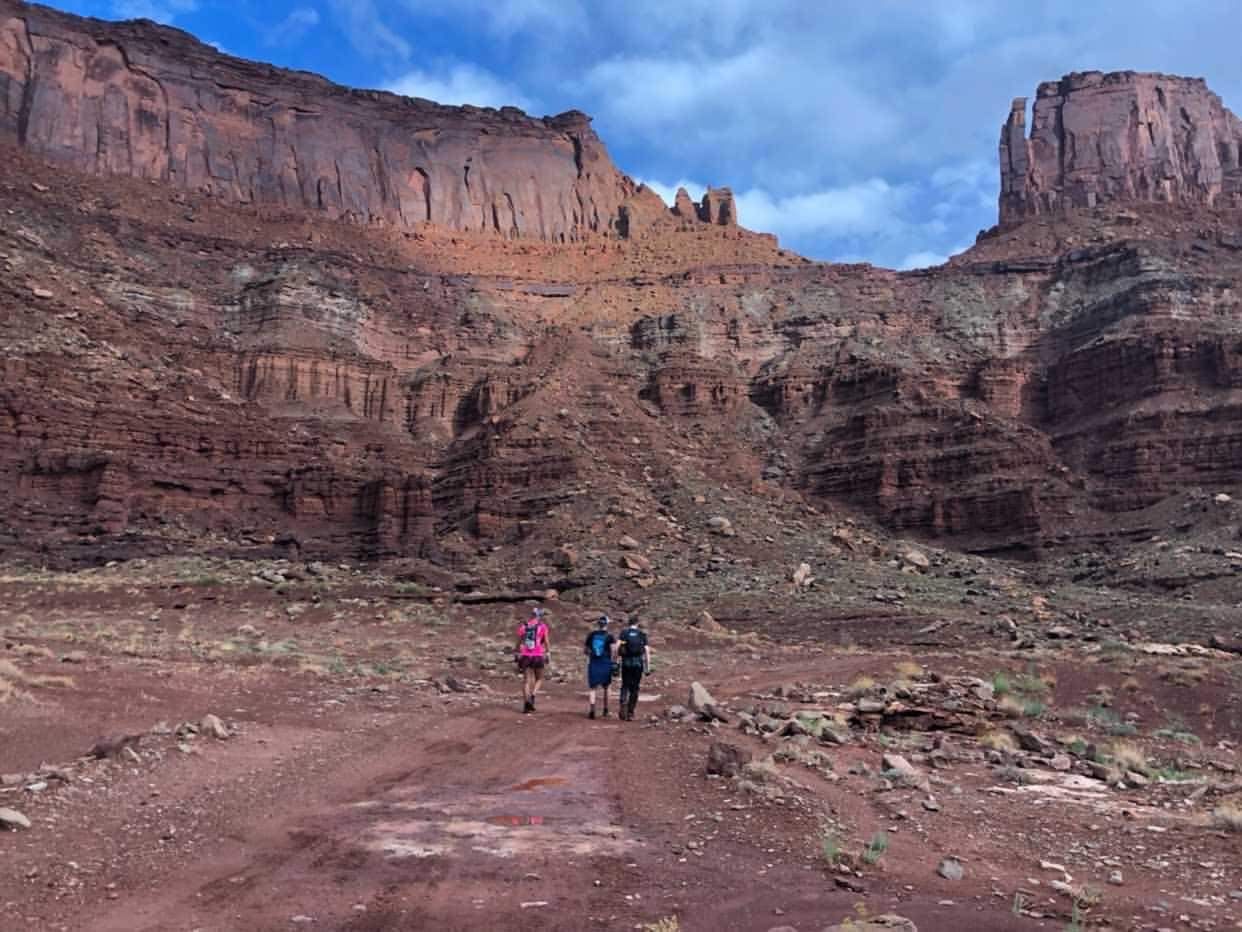
EVEN MORE amazing scenery
Day 2 - Saturday - (71 to 121 miles)
Aid stations: The Island, Bridger Jack, Shay Mountain
Seven hours later, and I woke up feeling refreshed and alive. A few body parts ached, but the fog over my mind had dissipated. I softly muttered to myself, “am I going to do this? Hell Yes!“. After changing clothes, cleaning feet, hitting the toilet bucket, grabbing a pancake breakfast, looking at the tired souls just arriving at the aid station, I headed out! After thanking the aid station volunteer who had persuaded me not to DNF, of course.
Walking out of the aid station I reflected on the night before. Previously the closest race to DNF’ing was at Bear 100 but compared to last night that had been just a passing thought. Valuable lessons had been learned:
- Rest fixes many issues
- Run my own race. In retrospect I pushed hard on day 1 to stay with my running friends
- Finish the race
Self-reflection complete. Time to swiftly jog towards the next aid-station.
The run from Indian Creek to the Island was very enjoyable. It started with a long downhill road, and then hit a pretty and very runnable trail. This section featured a dryish wadi and softly rolling hills. From a running perspective, this was probably the most enjoyable section of the whole race. Hitting the aid-station, 16 miles had been traversed in just under 4 hours. As an aside, when running these races I try keep friends and family updated via messages and short videos. Sadly there was no reception and so wasn’t able to send real-time updates, but I still recorded videos, which I have attached to this blog. To pass the time I entertained myself thinking about the messages my friends would have been sending during the night whilst I slept, “Why did he stop for so long?”, “Is he injured?”, “Is he going to DNF?“. The thought that against the odds I had continued was the highlight of my morning.
At the Island aid-station, I decided to risk having a hot dog, which was prepared by one of the kind volunteers. She insisted on finding me a large glass of coke, which really hit the spot as the day was getting hot. This reminded me to liberally apply sunscreen before heading out.
The path to the Bridger Jack Aid-station was gorgeous, navigating a valley and then climbing up along a vast exposed ridgeline with little shade. For this section, I had opted to increase the amount of water to 2.5L total, this was a good decision given the sun beating down. A chatty group of runners came-and-went as I was keen to “make hay while the sun shines” and didn’t want to stop to chat. As the route began to ascend, the views became even more spectacular. Physically and mentally I was feeling good, with moments when the struggle felt very real. Whilst the route was in theory accessible via vehicle, I struggled to imagine how crazy a driver must be to come along this road. The road was littered with huge rocks leaving very little room for error. This section felt very remote but lo-and-behold, a solitary 4x4 coming towards me, stopping and waving as I ran past.
As the climb got steeper and steeper the chatty group caught up with me, they moved very well on hills! This time I decided to chat with them, meeting Jackie, Walter and another gentleman I can’t remember the name of. It was a super fun conversation and helped to pass the time. Amazingly Jackie, Walt, and I had all run Yeti 100 in 2020 as well. Since the course was an out-and-back, we would have inevitably said hello at some point! I also learned that Walt held the World Record for most 100 milers run in a year, 50 - what an amazing achievement! Walt and Jackie had encyclopedia-like knowledge of races in the US and suggested a few gems to run in the future.
Pulling into Bridger Jack Aid station, 100 miles had gone by, only 140 more to go! This was my slowest 100 mile run finished in a total of 35 hours and 22 mins. Sitting back on comfy reclining chairs, Walt recommended the potato soup, which turned out to be an excellent choice. Whilst I had taped up my heel and ball of my feet from the start, my toes were only taped at The Island. This later taping had led to a pretty large blood blister on the left big toe, so I decided to re-tape at Bridger Jack. The medical staff and Jackie sorted me right out before heading out. After running together for a bit I decided to run alone for a bit, I bid adieu to Jackie and Walt and ran off towards Shay Mountain!
For those curious, my pacing chart had me arriving at Bridger Jack at 17:50 on Saturday and I actually arrived at around 17:22. So I was right on schedule, even with the previous long sleep, to hit Shay Mountain at 2 am Sunday morning, 44 hours after starting.
I began a game of leap-frog with a few folks for the next few miles of downhill running, in the back of my mind I knew what would be coming - a very long and steep climb out up Shay Mountain. After crossing a dry sand river bed, the path narrowed to a foresty single track. At this point the poles proved to be useful aids to jump across the numerous streams! As the night came I started to feel a bit tired, and the path got steeper and steeper, requiring semi-regular breaks to lower my heart rate. Eventually, Jackie and Walt caught up and overtook me with their impressive hill technique, their top tip was slowing down slightly and focus on consistency. I took this to heart and tried to push a slow down, and take fewer breaks. This seemed to work well and the aggregate pace felt better.
Given the distance the destination trail team did an amazing job marking the course, with only a few occasions where you needed to double check the route on your phone. The course was also uploaded to my Garmin watch, though with much lower fidelity. During a section which follows a twisting riverbed I missed a right turn, the course quickly got very technical and didn’t feel right but as I was tired so I ignored the signals and kept pushing on. I eventually double-checked my location with my phone and found out I had missed a turning. Thankfully the detour was short, around 0.5 km, so nothing too horrendous. After backtracking I was back on course and pushed on. Shortly afterwards, I hit the very steep part of the climb and according to my watch the gradient went all the way up to 30%! I was very grateful I had my poles to help keep me steady and avoid sliding downwards. This section was slow going, with many false horizons. To try deduce how much further until the top, I compared watch elevation to the GPX estimate, sadly this turned out to be inaccurate leading to bonus elevation to get to the top. After cresting the top, there was a reasonable downhill with a packed earth road before re-ascending up to the aid station. Even though the re-ascent was steep, it was much less technical. Arriving at Shay Mountain, I sat down in front of the fire, ate a hamburger, a pack of noodles, and asked for a spot in a sleeping tent, which the volunteers found for me. I closed my eyes and tried to go to sleep. Unlike the first night, I struggled to fall asleep as it was very cold at the top of Shay Mountain. Even though I had a good sleeping bag and I wore all the layers I could, it was still freezing. It didn’t help that my legs were very at this point painful - most probably due to all the elevation gain over the last 9 hours getting to Shay. In retrospect, I should probably have taken ibuprofen before sleeping, but I had decide to avoid taking any pills and save them for later in the race.
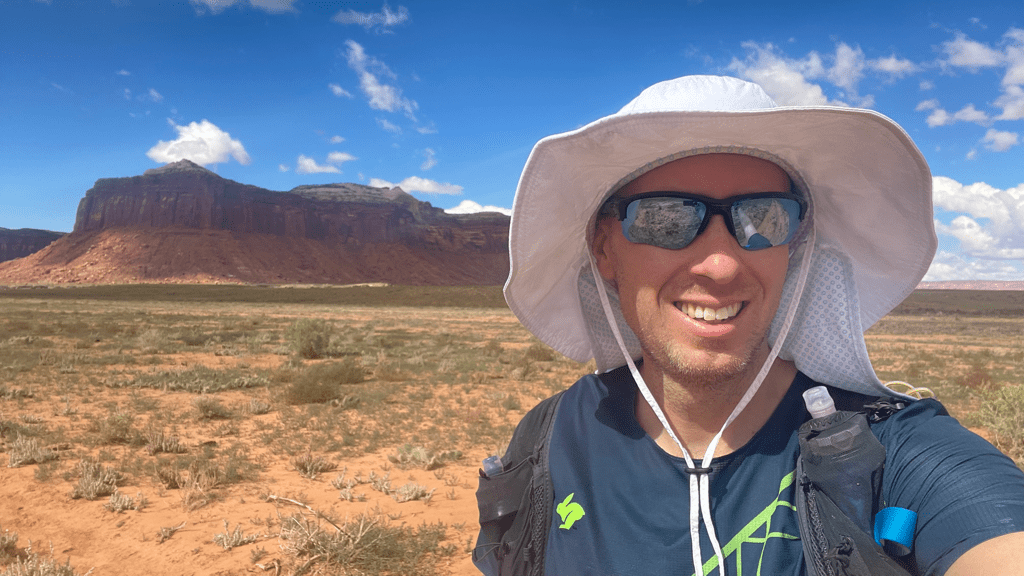
Towards the Island
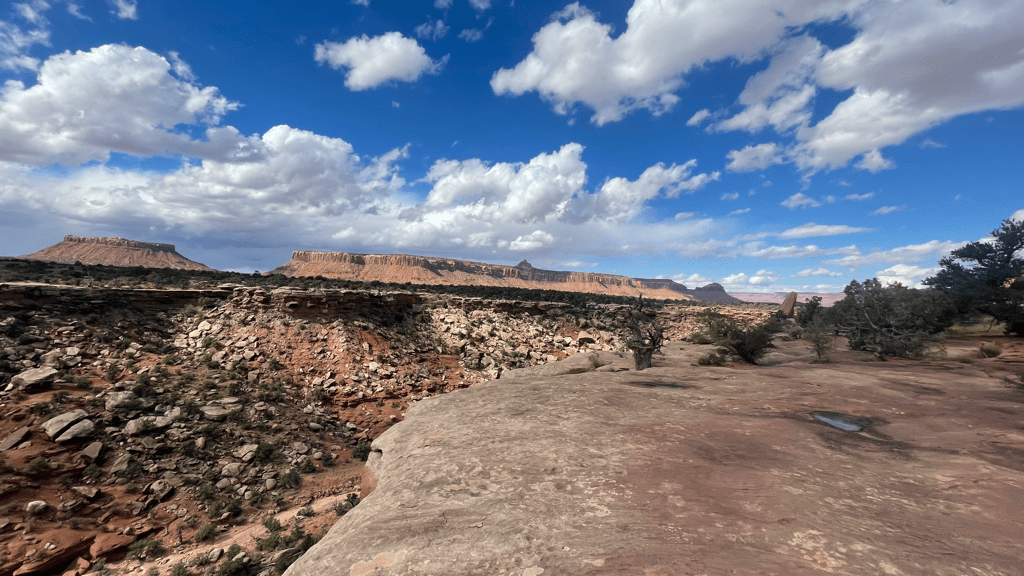
Bridger Jack Push
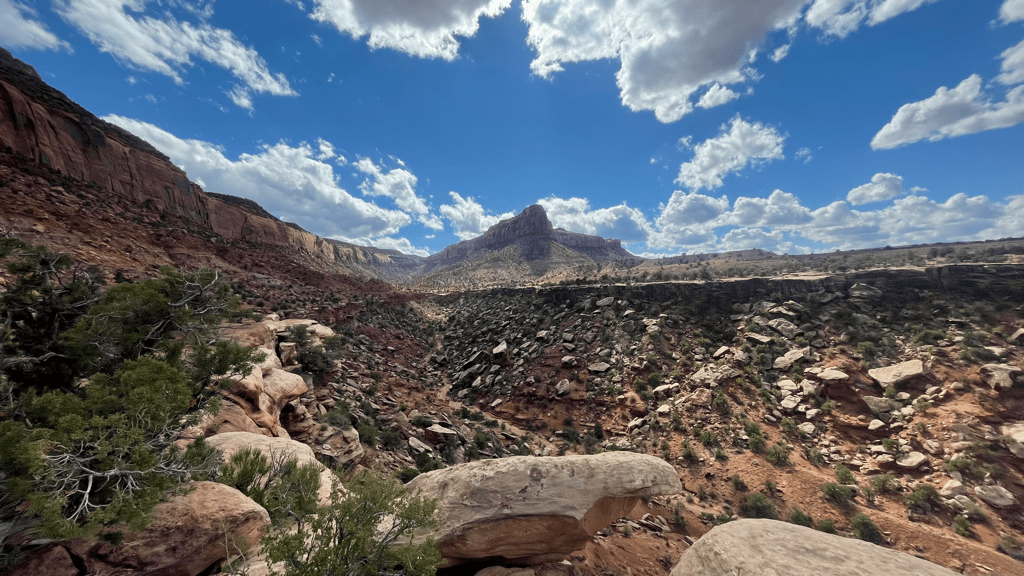
Bridger Jack Push
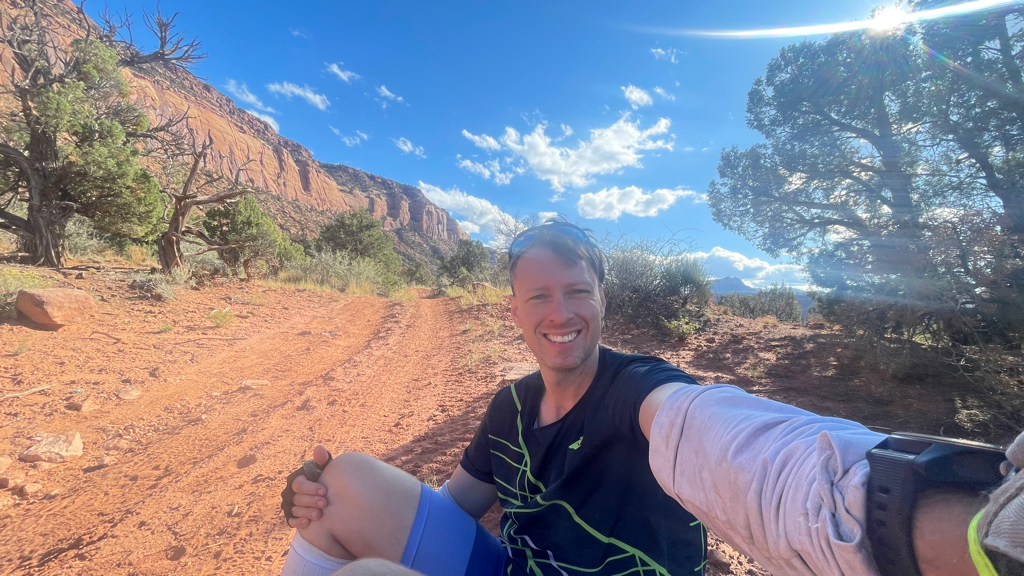
Warming up on way
Day 3 - Sunday - (121 to 167 miles)
Aid stations: Dry Valley, Wind Whistle, Rd46
I awoke around 5 hours after getting into bed, had some breakfast, and got my kit sorted for the day ahead. I walked back over to where I had left my poles the night before, and sadly they had vanished. The aid station crew looked around, but couldn’t find them anywhere or surprisingly any poles that had been left. So sadly I had to leave without them, I was frustrated with myself that I hadn’t put the poles in my bag the night before, as I had read in other race reports about people erroneously picking up poles. Hopefully someone would notice their mistake and drop my poles off at one of the next aid stations, ensuring poles for the La Salle Mountain range. Seven hours after arriving at Shay I was on my way to Dry Valley!
The morning was chilly but enjoyable with a nice road running section, followed by a right turn back onto trail. I had been avoiding listening to music but decided this was a good time to listen to some tunes, a relaxing coffee related podcast and then some rock songs, to provide motivation. Similar to the previous day I was able to make good time and overtook a bunch of people. Whilst this section wasn’t quite as postcard scenic as the last 2 days, it had its beauty and was much more runnable! There was also a good covering of trees, so even though it was sunny, it never got too hot - once I removed my layers. Overall this section proved pretty uneventful, and I was glad to hit Dry Valley around 1 pm, the perfect time for a spot of lunch - soup, and an avocado toast, luxury! In the aid station tent was Jackie and Walt so we had a little catch-up. Turns out they had got into Shay slightly after me. This was surprising as I didn’t remember passing them but the night had been very dark and I was quite focused on getting to Shay. Jackie mentioned she had been low on calories towards the end of that section and hence ended up slowing down. In the morning they had left an hour earlier than me from Shay, weirdly they had seen my poles when they left… I checked at the aid station, no poles dropped off - sad times! Whilst chatting, I investigated my wildcard drop bag which had a few random items in it, thankfully this included a large selection of first aid items. A day or so ago, I had developed a red rash on my feet and legs from what I think was a reaction to all the sand. I applied a little Benadryl cream to try to calm the red down and it reduced the discomfort somewhat. I also decided that this was a good time to take a couple of ibuprofen pills. About 45 mins after entering Dry Valley I headed back out. Seconds later, I realized I had forgotten one of my water bottles, so I walked back. I left again, and then realized I had forgotten nutrition for the next section, so I walked back again. I left again, and then realized I had forgotten my anti-chafing cream, so headed back AGAIN. FINALLY, I left. Only to realize I had forgotten my hat. I guess I must be a bit tired? On the fourth attempt, I managed to leave the aid station!
After a few minutes I caught back up with Jackie and Walt. In the morning, I had been contemplating if I should sleep at Rd46 Aid Station or push through until the end of the race, and wanted to get their advice given they had both completed 200-mile races before. After a bit of discussion, they helped me make the decision that I would push through until the end. Two factors helped me make this decision. Firstly, I had a reasonably large amount of sleep early in the race. Secondly, there was a cold and rainy weather front coming in. By my calculations, if I could finish by the very early hours of Tuesday morning, I would just miss this whereas if I slept I would have to endure potential snow and rain. I was very grateful for all their advice, wished them the best of luck, and pushed on. That would be the last time I would see them for the rest of my race. This may sound like an easy decision, but it meant committing to around 40 to 50 hours of non-stop running.
The route to Wind Whistle was very runnable and I made good pace. In the far far distance you could see the mountain range all runners would need to cross. Best not to dwell on the huge distance still to go, 100 miles give or take. A little before sunset, 17:30, I arrived at the very beautiful Wind Whistle aid station. The highlight of this aid station was running into the volunteer who had talked me into continuing back at Indian Creek, she was delighted to see I was still going! It started to get chilly whilst I tended to foot care and warm food. One mistake was eating the Mexican food at the aid station, it was rather spicy and after two bites I had to put the plate down and quickly pivot back to vegetable soup. Sadly the spice played punch bag with my stomach for the next 4 hours or so.
Exiting Pole Canyon I started chatting to a chap called Tony Cline and his pacer. He had successfully run the Bear 100 race a few weeks prior, which I thought was wild, and now taking on this challenge. He was in some pain, but pushing on - we had a fun chat before I pushed on, I’m glad to see he managed to push through and finish the race! The rest of this section was reasonably runnable, and not particularly noteworthy apart from a dead snake I saw on the ground!
As I was rolling up to the Rd46 Aid Station, it was getting very cold and annoyingly I put my foot in some water and got wet socks. Joy.
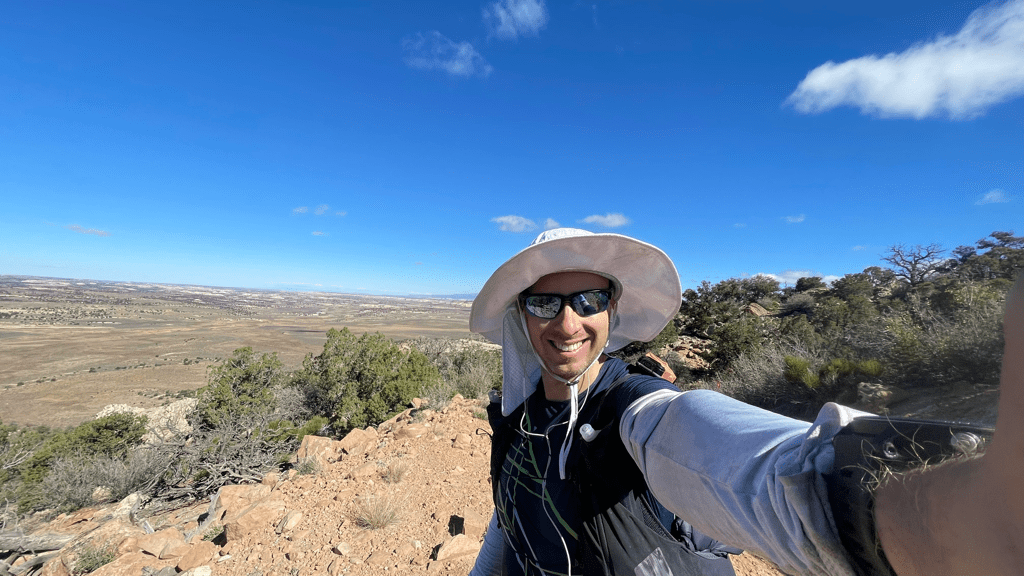
View with La Salle Mountains in the background
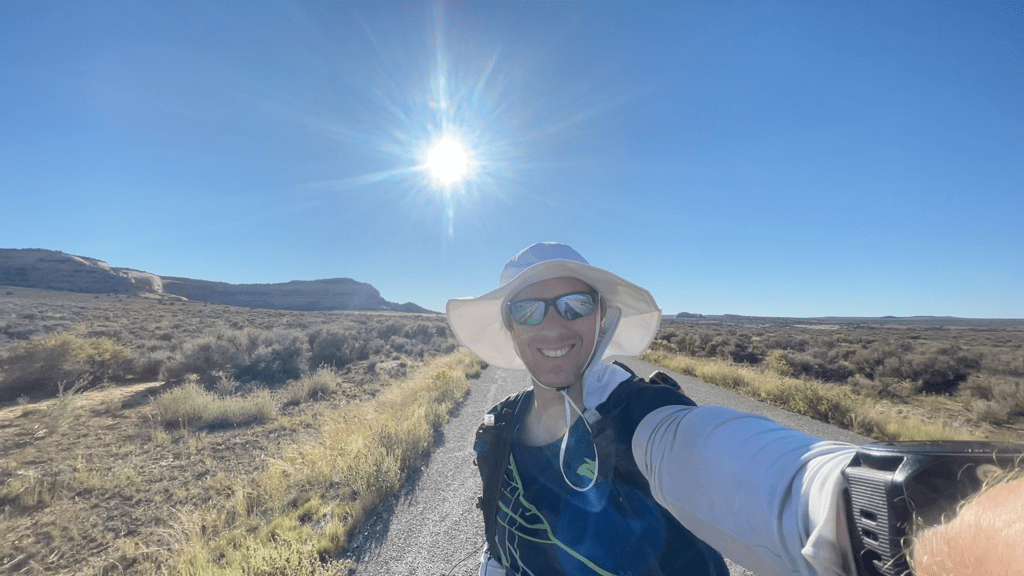
Long road before Wind whistle
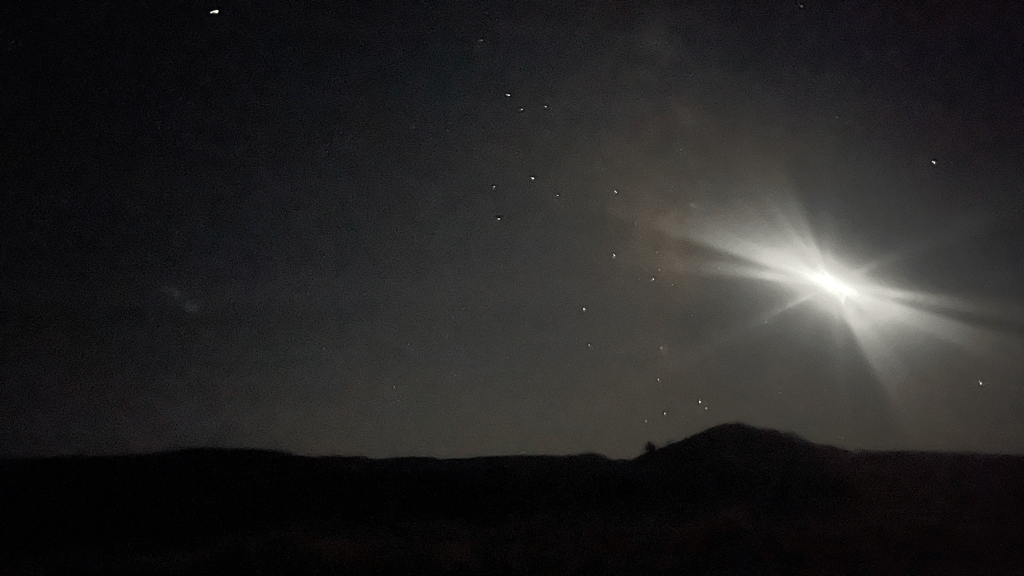
Bright night stars
Day 3 to 4 - Sunday night / Monday Morning - (167 to 185 miles)
Aid stations: Pole Canyon
10 pm on Sunday and I was ready to push through until the end. On arriving at the Aid Station I quickly ordered a burger and some soup. My Aid Station bag had a bunch of extra warm gear for what was going to be the coldest part of the whole run. I sat by the fire, added layers, and swapped out my wet socks. Talking to a few pacers and a gentleman who had DNF’d earlier they strongly suggested I team up with another runner and work together through the night. One of my new friends asked the aid station crew to let me know if someone was up for running together and a few minutes later they notified me someone was ready to go! I quickly wolfed down the rest of my food and finished getting ready. Due to the relatively dangerous nature of this next section, there was a full kit check to ensure we had all the items necessary if anything were to go wrong and be able to hold up until help arrived, which could be many hours after any accident.
A few minutes later I met up with Remo Spagnol, who I would be running with. Remo was a fascinating chap, who had a very impressive ultra running resume. He was also extremely efficient at power walking! As we started to ascend the rugged mountain I found myself struggling to keep up with Remo. I told him that I couldn’t keep up and to feel free to leave me and push on. The true gentleman that he is, he said he was willing to slow the pace down and work together. I was glad we had this conversation as I struggled a lot on this section. My biggest issue stemmed from having lost my poles and having to revert to the hands-on-knees technique for the ascends. This not only meant my effort was higher, but due to the strain my shoulder blades would sporadically have little painful spasms. Lying down and having mini trail naps/stretches would help, but the going was slow. The trail was also incredibly technical which meant a lot of mental effort had to be spent to pick a path through the rocks. After 67 hours since leaving the start line, this was at the limit of my mental capacity. But on-wards we went. Remo had a trail running light that went around your waist, and the amount of light these put out is stupendous, can’t say I wasn’t slightly jealous! Upwards and upwards we went, colder and colder it got - with puddles of water now frozen, but we were getting done…
A few km away from the aid station, I suddenly heard my name! I was a bit dazed, so I couldn’t figure out whose voice it was. Amazingly, it turned out to be Kit and his pacer Greg. They let us know we weren’t far from the top, and then they pushed on! As we got to Pole Canyon at 5 am on Monday, I was struggling, and decided to take 80 minutes to relax and let the sun come up before heading off. I thanked Remo for the great teamwork and warmed up in front of the fire until I knew it was now or never! Around 7 am, I left the aid station. It was still bloody cold.
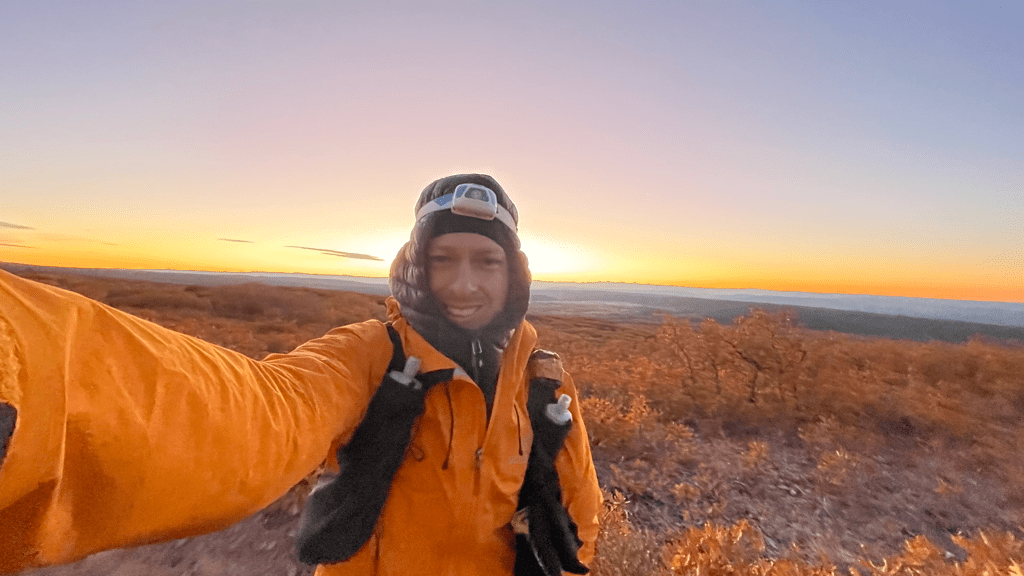
Leaving Pole Canyon
Day 4 to 5 - Monday & Tuesday Morning - (185 to 240 miles)
Aid stations: Horse Creek, Porcupine Rim, Finish
I thought that the run from Pole Canyon to Horse Creek was broken into 2 main sections, firstly a little ascent and then a rapid descent to an unmanned water station, followed by a winding road climb into the Aid Station. Only one of these two would turn out to be correct.
The first section started well enough, though I was still struggling with spasms in my shoulders. I tried to fix this by making a few adjustments and moving more of the pack weight onto my chest. This helped and the pain diminished somewhat. I was also taking ibuprofen at a regular-ish interval, maybe 2 tablets every 6 ish hours, which helped a ton. After the “ascent”, which actually turned out to be steep rolling hills, I was looking forward to hit the nice long downhill 8 km section. Cresting the hill and turning onto the downhill I was presented with an EXTREMELY technical trail. Imagine running along an exposed riverbed full of rocks. The thought of any decent running was blown and instead I got to enjoy what felt like hours and hours of slowly picking my way through the rocks trying to avoid twisting an ankle. Once again I missed my running poles. To pass the time I began chatting to a runner and his pacer, I think his name was Anders, which helped a bit in lowering misery! We eventually hit the bottom of this heinous section and started the windy ascent up to Horse Creek.
Arriving at Horse Creek felt amazing as this meant the end was relatively near… with a lot of downhill until the end. Whilst all the aid stations were great, this one, in particular, was very impressively run with a great at-seat dining experience! I changed the tape on my feet, had a delicious burger, and headed out for my final night on the trail. I chatted to many interesting folks, and was particularly impressed with the hill technique of a lady named Bri! I also happened to spot Remo from earlier at the aid station, but he was having a great chat with ultra running legend Jeff Browning, so I didn’t want to interrupt. 81 hours after starting, at 3 pm on Monday, I headed towards the final aid station before the finish.
I will admit, I enjoy running more than I enjoy power-hiking and so for me, this section was one of the most enjoyable of the race. Most of the next 18 miles were gradual downhill on soft trails, I tried to push hard and enjoy this section. I was met with a lovely sunset and endless views. I knocked off the 18 miles and arrived at Porcupine Rim in just under 5 hours. Not bad for someone who had just run 200 miles! 18 miles left, less than a half marathon to go!
When entering the Porcupine Rim aid station, I wanted to continue momentum and so, I took a page out of my 100 miler book. Instead of stopping for food, I refilled my water bottles, grabbed a pot noodle to go, and carried on going, eating on the go. I felt really good and couldn’t wait to get this race done. 8 pm on Monday, 86 hours after starting, all downhill from here until the end.
The start was quite interesting, with a nice gradual downhill on a sandy road. Sadly the wind had picked up resulting in wind gusts throwing sand into my eyes, ears, nose, and mouth, which was horrendous. I had read that this could be an issue in Moab and thankfully this was the first time I had to endure it. I put my earphones in, my transparent lenses into my glasses, and used my buff to cover my mouth and nose. This worked reasonably well with the trade-off that breathing was harder. Furthermore, if you breathed too hard, you would just suck the fine-grained sand through the buff. Keeping sand out of my mouth proved to be a challenge for the rest of the race. Even when the wind died down, there were micro-particles everywhere. An annoying side effect was that it made me drink more water to quell the dryness in my throat.
After a decent downhill section, the climb up Porcupine Ridge began. At night, this was a slightly frustrating technical trail to run, with just enough rocks to make running without thinking difficult. Pushing as much as I could I fell into a zombie mode where all thoughts were focused on pushing through to the end - telling myself grind, grind, grind, grind. Slowly the miles ticked away. As I mentioned before, I had no reception on my phone for the last 4 days, and suddenly, with a bit of reception, messages flooded in. In particular, I had a bunch of messages from Sam telling me to hurry up and get it done! For some reason, this push delivered a surge of adrenaline and I was able to pick up the pace.
Coming down the Porcupine Ridge line there was an amazingly fun bit of running which involved some scrambling up-and-down rocks and then finally dropping down and through a tunnel. What an amazing way to finish the trail section of the race. A final 5 km push along the bike path into Moab and I was done. From 6 am Friday until 2 am Tuesday, 92 hours of effort. phew. done.
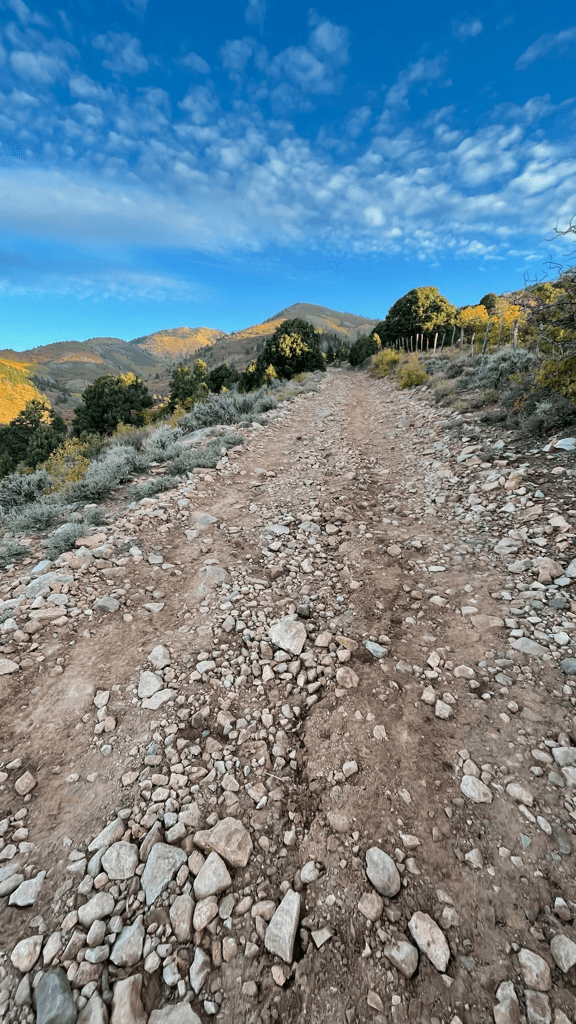
Pretty but painful climb
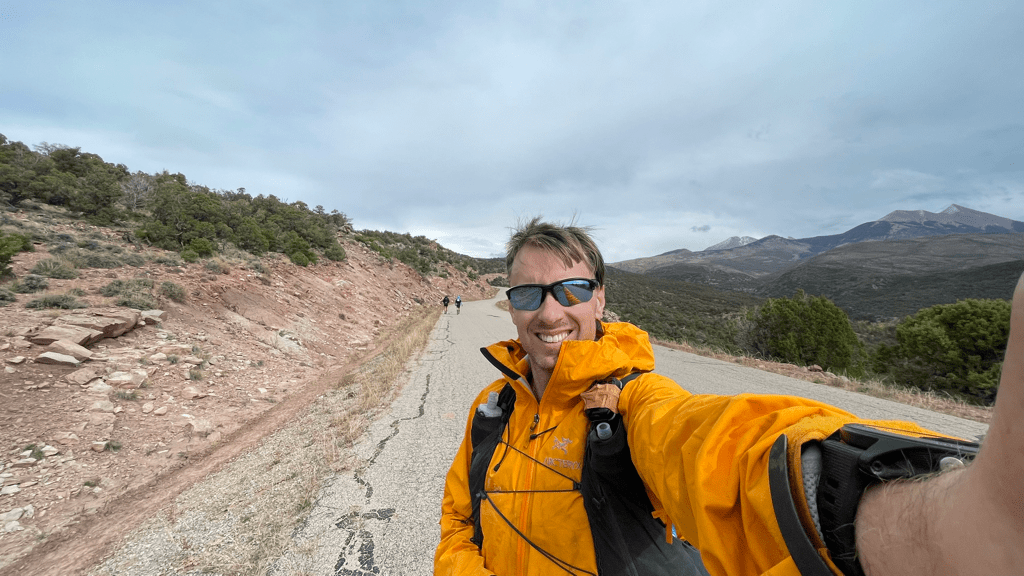
Hill Climb

Course View
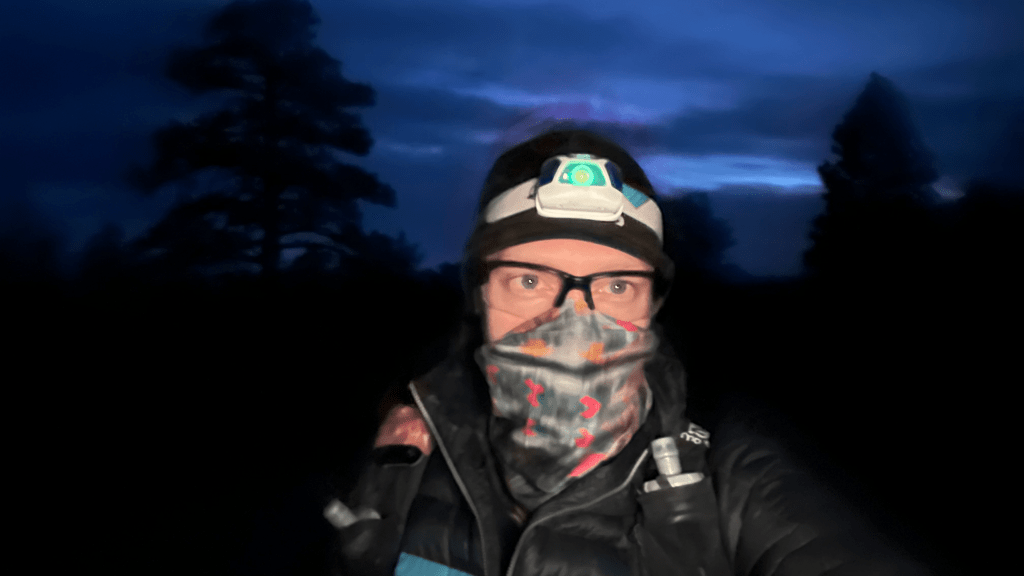
Avoiding dust
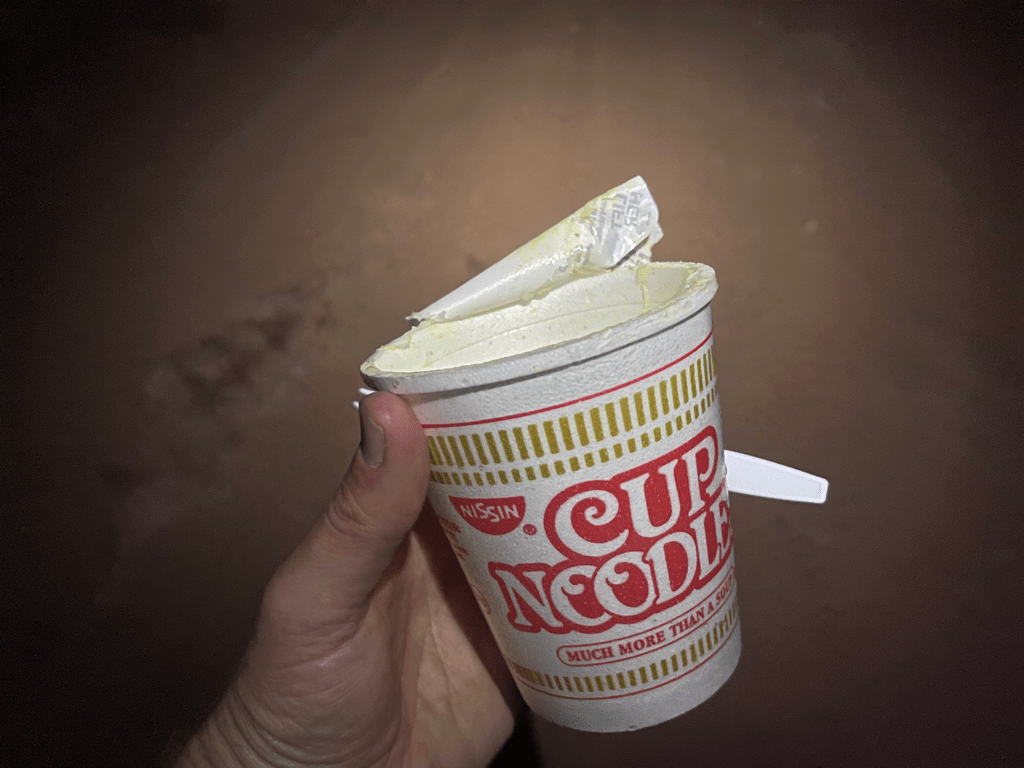
Last meal
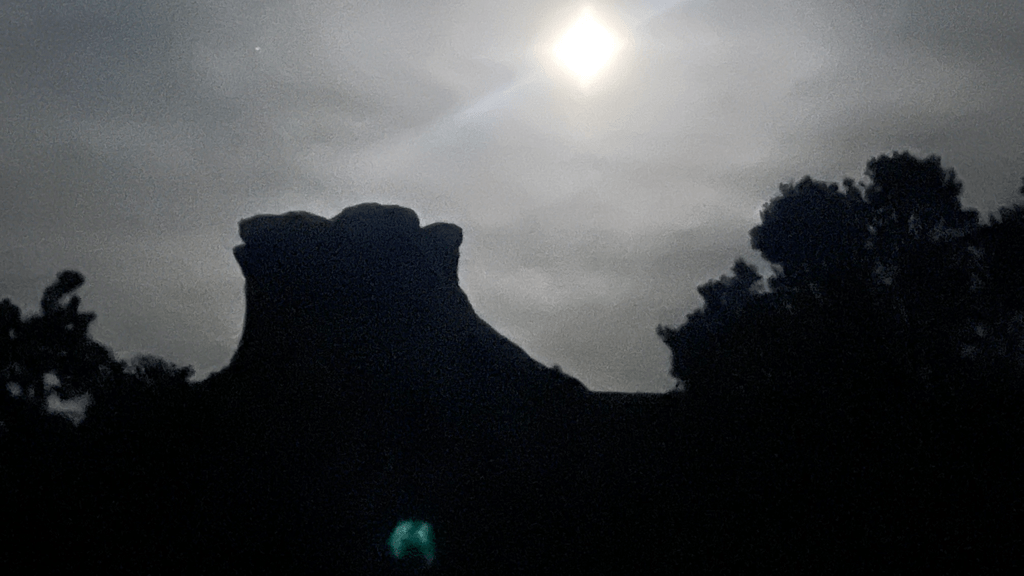
Final view
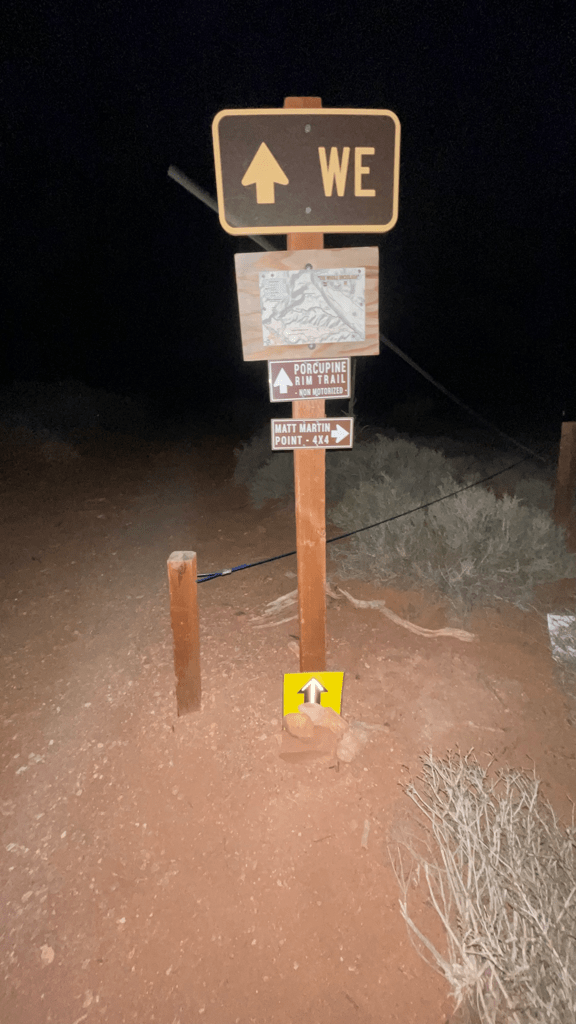
Final ridge line
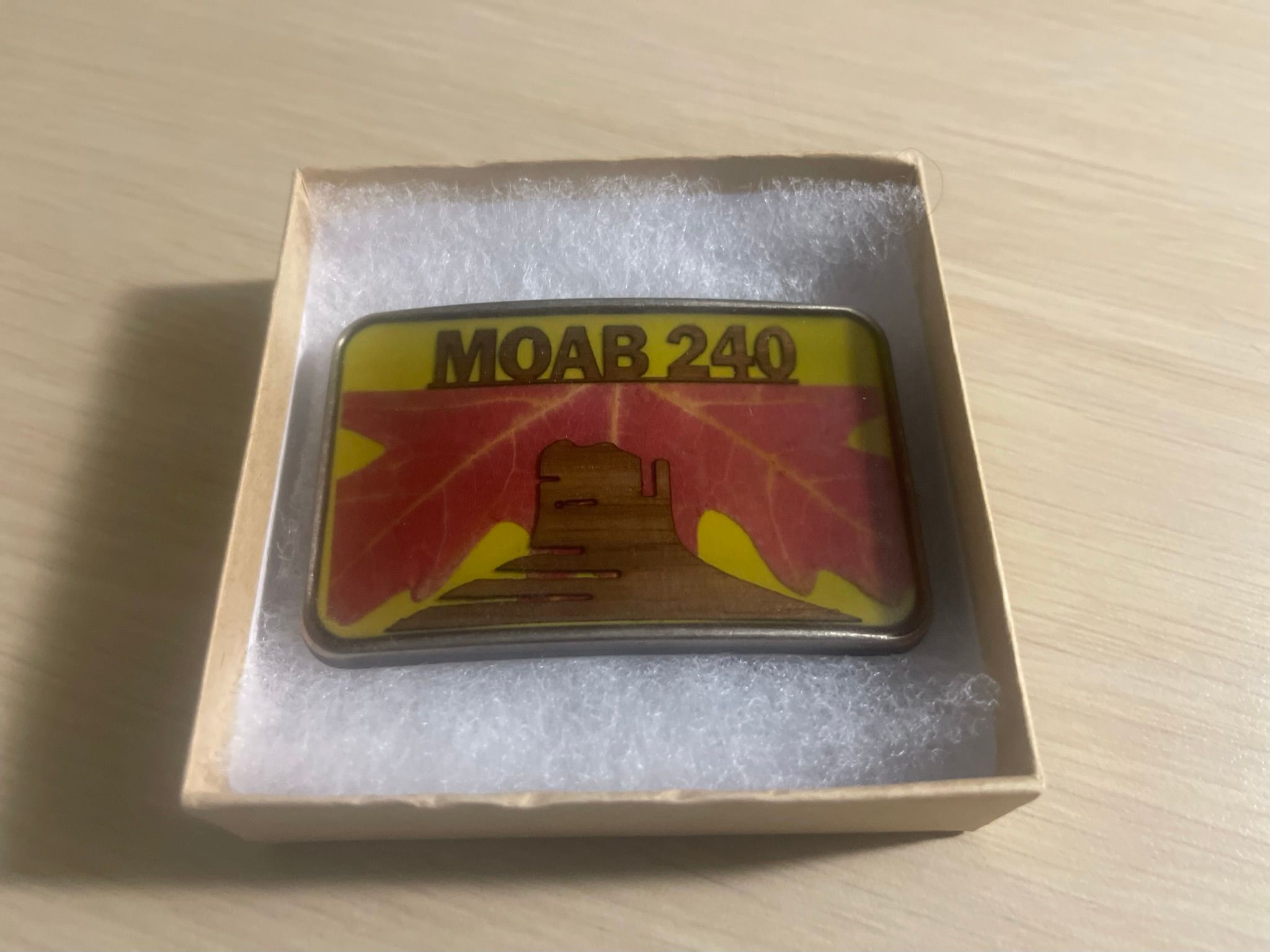
Got that buckle!
Post-race
Almost as soon as I crossed the finish line the bad weather arrived. I was glad to be finished but felt bad for the runners still out there. It was going to be a very hard and cold night. After having a quick drink I arranged a lift back to my hotel via the generosity of another runner’s crew. At the hotel I tended to my wounds, ate some food, and fell into a glorious 5-hour sleep!
The next morning I popped over to visit Kit and crew to see how his race had gone - I just missed him at the finish line as he had finished an hour and a half before me. It was interesting to hear the very different way the race had played out. We also hit a local Burrito place and did their humongous burrito challenge, the only food challenge I have been able to complete!
I then headed back to the race finish to watch Walt & Jackie come-in, they were wet but happy! I also heard from other runners how the conditions had got pretty bad during the night, including the technical Porcupine Ridge trail getting covered in snow! I popped back again to watch the nail-biting final half-hour where a couple of runners finished in the final minute of the race. What a crazy emotional experience to watch and so glad they managed to find that final bit of adrenaline to finish in time…
After another night sleep, I made my way back to San Francisco on Wednesday morning via Salt Lake City. As a public service announcement, be very very cautious about driving back after these sorts of races. Though I had 2 nights of sleep, the dropping adrenaline levels and general tiredness resulted in very challenging driving.
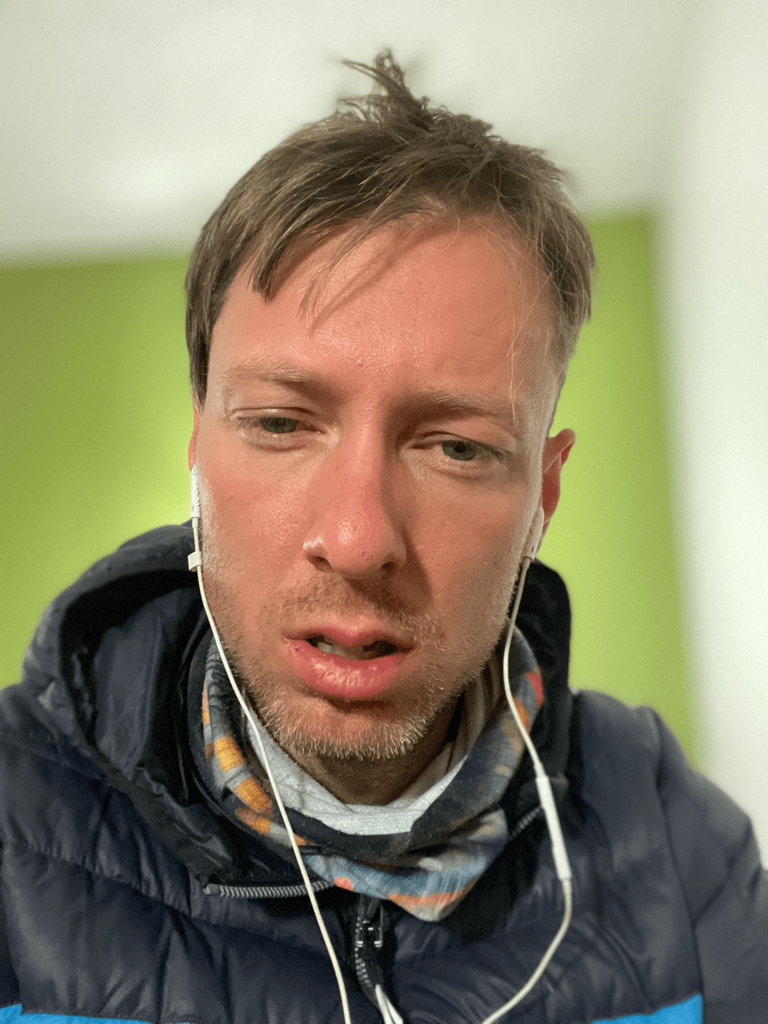
At the hotel, but tired
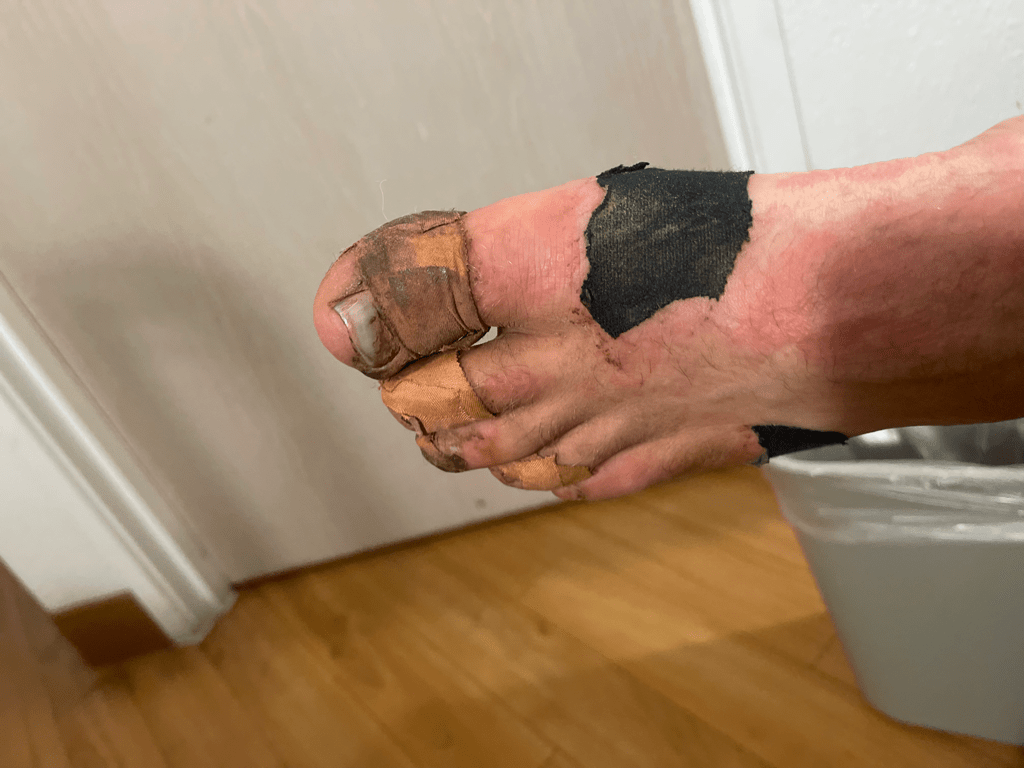
Gorgeous feet
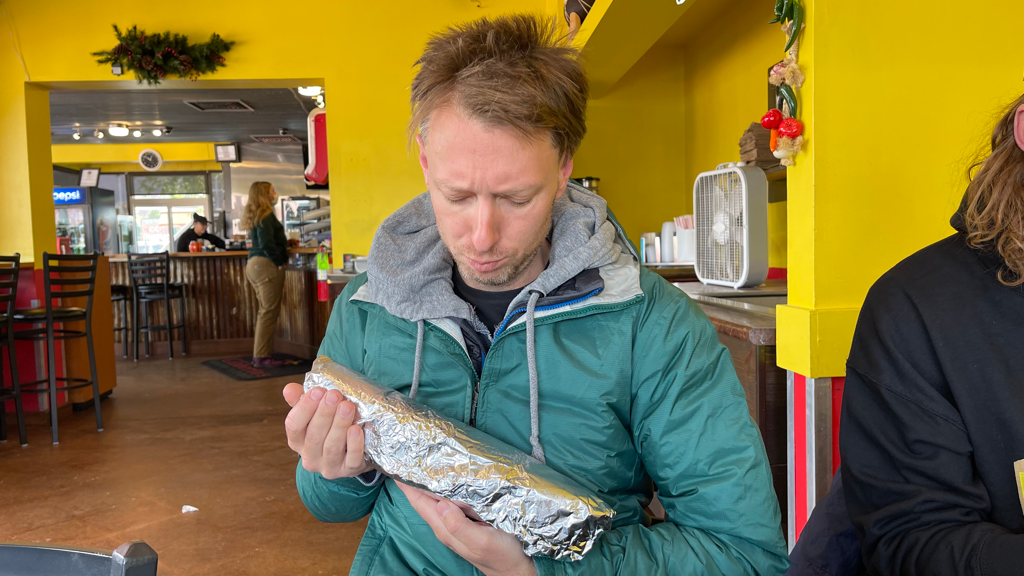
Burrito Challenge!
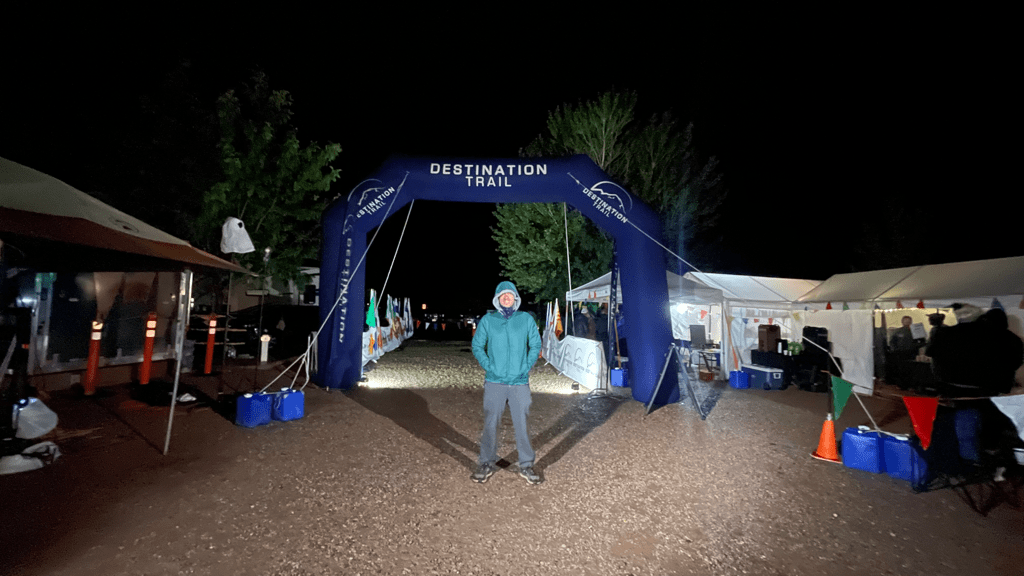
Watching the final finishers
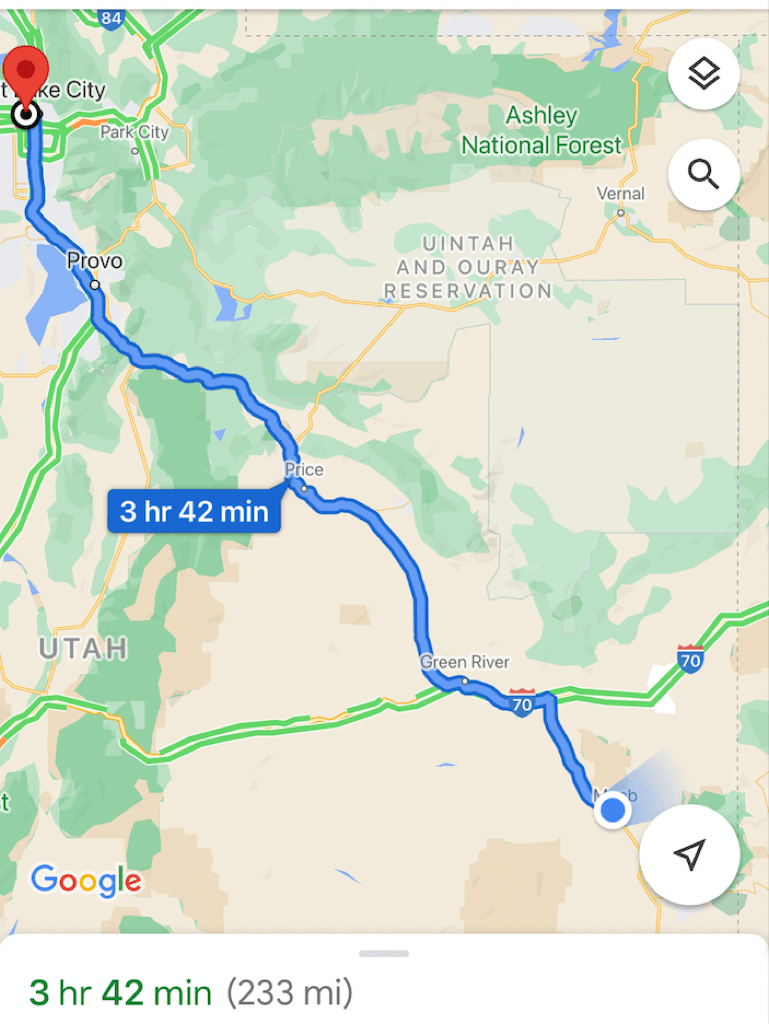
How is the drive back shorter than the race?
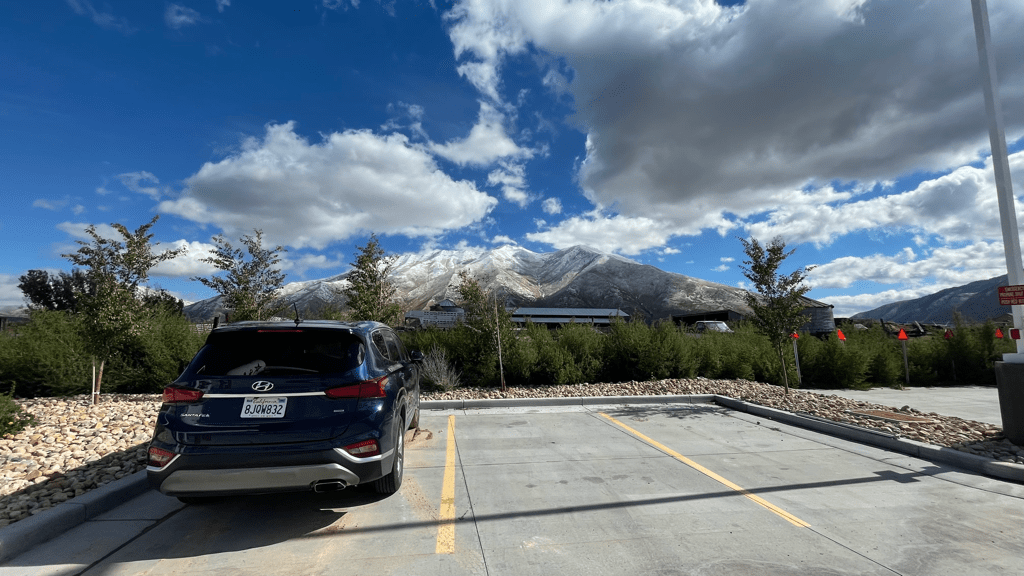
Mid-drive nap